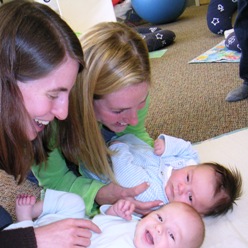
Supervised short periods when baby is placed on her belly while awake, called Tummy Time, may seem more like a struggle than a play time. Why is tummy time so important, and what can you do to encourage a baby’s participation?
- The main goal of tummy time is neck, shoulder and arm strengthening. This is the beginning of head control and upper trunk and balance development needed for sitting and standing.
Help your baby by positioning her arms so she can use her forearms to press against and lift her neck. Even if she just brings her head up for a few seconds then rests it back down, she’s beginning to develop those (Sternocleidomastoid) muscles. - Propped positions may work better. Many babies who fuss during tummy time on a flat surface do much better in a propped position. Try tightly rolling a blanket or towel into a firm bolster, then position baby in a kneeling position with her tummy right up the bolster, and with arms tucked up at chest level. This way she’ll have some leverage and will use her arm and shoulder muscles to push with, and be able to raise her head. You may need to reposition your baby’s arms often if she tends to bring her arms by her side and “swim”, or slides down the bolster.
- Engage and distract! Tummy time is a partnership activity. Encourage and tempt your baby to lift her head to see what’s going on. Use a favorite board book, rattle or toy to capture her attention and experiment with different locations for tummy time both indoors and out. Child-safe mirrors are great – who wouldn’t want to look at that beautiful baby?
- Brief but frequent. Instead of thinking of tummy time as a daily 15 minutes to endure, place your awake baby on her tummy for shorter sessions throughout the day, and don’t let baby get too distressed. Just like going to the gym, it’s the frequent and regular exercise that begins to build muscle strength, which eventually will make tummy time sessions much easier for your baby, and therefore, for you!
- Watch your baby progress! At one month, expect some brief head lifting or bobbing, at two months, her head may be held up for longer periods. Around three months, expect to see her support herself on bent arms during tummy time and at four to five months, baby may be able to push up higher, keeping shoulders and upper chest off the surface. All this prepares your baby for trunk control and tripod sitting around five to six months!
Tummy Time FAQs
My two month old really hates tummy time. We try every day but I quickly “rescue” her because she’s fussing. Should I continue or wait a few weeks and start over?
Continue, but for brief periods that (hopefully) remain mostly positive experiences. Because infants tend to spend most of their time in reclined positions like a car seat, swing or bassinet, they aren’t often encouraged to “work on” those arm/shoulder/neck muscles. Also, the passive recline position puts pressure on the back of the baby’s head, which can lead to flat spots. Vary your baby’s position many times throughout the day, and keep tummy time one of the positions in regular rotation. Hopefully the tips shared above will help her tolerate the brief sessions better and as she builds more upper body strength, it will become less of a challenge for both of you.
When do we stop doing tummy time? My 5 month old just flips right over onto his back. Can we stop now?
Congratulations! Tummy time doesn’t really go away, it just evolves into “Floor Time”. It sounds like your baby is learning how to maneuver his body and will soon be moving around more. Place your baby (on his tummy) on a clean and safe floor area a few times each day, so he can work on learning to roll and explore. When he rolls over onto his back, place some interesting toys near him just barely out of reach and soon he will work on pivoting around or rolling back onto his tummy to explore what’s around him. Because babies often move backwards before they learn to creep forward, reduce frustration by putting several toys around him in a circle so whatever direction he ends up in, there’s a reward nearby. Floor time is just as essential as tummy time, and is the best place for baby to develop his gross motor (body movement) and fine motor (hand-eye coordination) skills.



